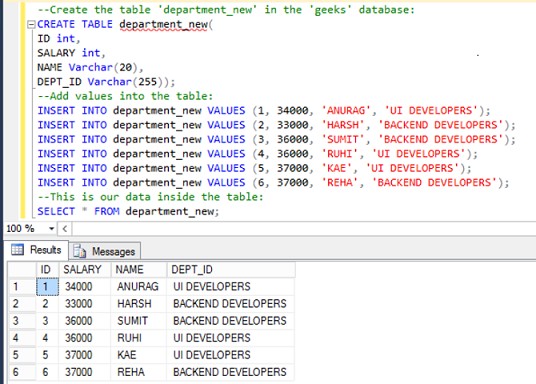Structured Query Language (SQL) is the backbone of modern database management, essential for creating, maintaining, and retrieving data from relational databases like MySQL, PostgreSQL, and SQL Server. A common task for database administrators and developers is to compare two tables within a database to identify similarities, differences, or discrepancies. This process is crucial for data auditing, synchronization, and ensuring data integrity across different versions or sources.
This guide will walk you through a practical method to compare two tables in SQL and pinpoint the differences using the UNION ALL and GROUP BY clauses. We’ll set up a sample database and tables to illustrate the process clearly.
Setting Up the Environment: Database and Tables
First, let’s create a database named geeks to house our example tables. Execute the following SQL command:
CREATE DATABASE geeks;Next, we need to instruct SQL to use the newly created geeks database for subsequent operations:
USE geeks;Now, let’s define the structure for our two tables: department_old and department_new. These tables will mimic scenarios where you might have an older version of a table and a newer, potentially modified version.
Here’s the SQL to create the department_old table:
CREATE TABLE department_old (
ID INT,
SALARY INT,
NAME VARCHAR(20),
DEPT_ID VARCHAR(255)
);And here’s the SQL to create the department_new table, with an identical structure for comparison purposes:
CREATE TABLE department_new (
ID INT,
SALARY INT,
NAME VARCHAR(20),
DEPT_ID VARCHAR(255)
);Populating Tables with Sample Data
With our tables created, we’ll insert some sample data into both department_old and department_new. This data will help us demonstrate how to compare the tables and find differences.
Insert data into the department_old table using these SQL statements:
INSERT INTO department_old VALUES (1, 34000, 'ANURAG', 'UI DEVELOPERS');
INSERT INTO department_old VALUES (2, 33000, 'HARSH', 'BACKEND DEVELOPERS');
INSERT INTO department_old VALUES (3, 36000, 'SUMIT', 'BACKEND DEVELOPERS');
INSERT INTO department_old VALUES (4, 36000, 'RUHI', 'UI DEVELOPERS');
INSERT INTO department_old VALUES (5, 37000, 'KAE', 'UI DEVELOPERS');To verify the data in department_old, you can use the following SELECT statement:
SELECT * FROM department_old;This will output the following table:
| ID | SALARY | NAME | DEPT_ID |
|---|---|---|---|
| 1 | 34000 | ANURAG | UI DEVELOPERS |
| 2 | 33000 | HARSH | BACKEND DEVELOPERS |
| 3 | 36000 | SUMIT | BACKEND DEVELOPERS |
| 4 | 36000 | RUHI | UI DEVELOPERS |
| 5 | 37000 | KAE | UI DEVELOPERS |
Now, let’s populate the department_new table. Notice we’re adding one extra record compared to department_old to showcase a difference:
INSERT INTO department_new VALUES (1, 34000, 'ANURAG', 'UI DEVELOPERS');
INSERT INTO department_new VALUES (2, 33000, 'HARSH', 'BACKEND DEVELOPERS');
INSERT INTO department_new VALUES (3, 36000, 'SUMIT', 'BACKEND DEVELOPERS');
INSERT INTO department_new VALUES (4, 36000, 'RUHI', 'UI DEVELOPERS');
INSERT INTO department_new VALUES (5, 37000, 'KAE', 'UI DEVELOPERS');
INSERT INTO department_new VALUES (6, 37000, 'REHA', 'BACKEND DEVELOPERS');Verify the contents of department_new with:
SELECT * FROM department_new;This will display:
| ID | SALARY | NAME | DEPT_ID |
|---|---|---|---|
| 1 | 34000 | ANURAG | UI DEVELOPERS |
| 2 | 33000 | HARSH | BACKEND DEVELOPERS |
| 3 | 36000 | SUMIT | BACKEND DEVELOPERS |
| 4 | 36000 | RUHI | UI DEVELOPERS |
| 5 | 37000 | KAE | UI DEVELOPERS |
| 6 | 37000 | REHA | BACKEND DEVELOPERS |
 SQL Output Showing department_new Table Content
SQL Output Showing department_new Table Content
The UNION ALL and GROUP BY Approach to Compare Tables
Now for the core of our task: comparing the two tables. We’ll leverage UNION ALL to combine the rows from both tables and then use GROUP BY and HAVING to identify rows that are not present in both.
The UNION ALL operator stacks the result-sets of two or more SELECT statements on top of each other. Critically, it includes all rows, even duplicates, which is essential for our comparison. GROUP BY will then group these combined rows based on the columns we want to compare. Finally, HAVING COUNT(*) = 1 filters out groups that appear only once, indicating rows that are unique to one of the tables.
Here’s the SQL query to compare department_old and department_new based on all columns:
SELECT ID, SALARY, NAME, DEPT_ID
FROM (
SELECT ID, SALARY, NAME, DEPT_ID FROM department_old
UNION ALL
SELECT ID, SALARY, NAME, DEPT_ID FROM department_new
) AS CombinedDepartments
GROUP BY ID, SALARY, NAME, DEPT_ID
HAVING COUNT(*) = 1;In this specific example, if you execute this query, you will get the following result:
| ID | SALARY | NAME | DEPT_ID |
|---|---|---|---|
| 6 | 37000 | REHA | BACKEND DEVELOPERS |
Understanding the Results and Limitations
The output shows the row with ID = 6, which is present only in the department_new table. This indicates that this row is a difference between the two tables. If there were rows present only in department_old or rows with modifications in department_new compared to department_old (that makes the whole row different), those rows would also appear in the result.
However, if the tables are identical in terms of the columns you are comparing, the query will return no rows. This is because every row would appear twice in the UNION ALL result (once from each table), and GROUP BY with HAVING COUNT(*) = 1 would filter out all such rows that appear more than once.
Limitations:
- Comparing All Columns: This method compares rows based on all specified columns. If you only want to compare specific columns, you need to adjust the
SELECT,UNION ALL, andGROUP BYclauses accordingly. - Performance on Large Tables: For very large tables,
UNION ALLfollowed byGROUP BYcan be resource-intensive. Performance optimization techniques and alternative comparison methods might be necessary for extremely large datasets. - Identifying Modifications: This method primarily identifies rows that are added, deleted, or entirely different. It doesn’t directly pinpoint which columns within a row have been modified if the row exists in both tables but with different values in some columns. For detailed column-level comparison of modifications, more complex queries or dedicated data comparison tools might be required.
Conclusion
Comparing two tables in SQL is a fundamental operation for data management and analysis. The UNION ALL and GROUP BY approach provides a straightforward and effective way to identify differences between tables, particularly for finding added or removed rows. While it has limitations, it serves as a valuable technique in many scenarios for ensuring data consistency and understanding changes across database tables. By understanding this method, you can effectively Compare 2 Tables In Sql and manage your data more efficiently.
